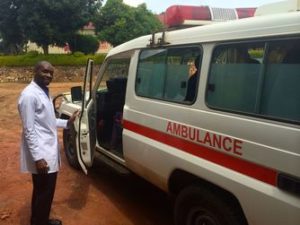
What comes to mind when you think about access to lifesaving medical care?
Most of us think about ambulances and emergency rooms, insurance and wait times, maybe even scenes from the television show “ER”. We have come to expect, and sometimes even take for granted, a very high level of emergency care. When we have an emergency, we have a very good chance of being taken care of by a highly trained professional and surviving. In the U.S. if you or your child is injured or very ill, you can call 911 and expect first responders to rush to you and provide care. You will then be hurried in an ambulance to an emergency department where you will be triaged based on the severity of your condition. You will be seen, immediately if necessary, by a well-trained emergency physician. This is how the emergency care system works in the U.S.

But it doesn’t work this way in many other parts of the world.
After all, most of us don’t start preparing for a child’s death simply because they have diarrhea. If they are too dehydrated, we rush to the emergency department and get immediate care. Lifesaving care. And we don’t think twice about it. Yet, there are over 750 million people in the world today who don’t have that same access to emergency medical care.
Think about that. 1 out of 10 people worldwide are haunted by death when faced with even the simplest, but urgent, medical issue or injury. That’s a huge number of people who lack access to the very same lifesaving medical care that’s so readily available to us. Even our kindergarteners are trained to access it: “If there’s an emergency, dial 9-1-1.”
But for those without access, an easily treatable condition such as malaria or pneumonia can become a death sentence. In sub-Saharan Africa, 8% of children do not live to see their 5th birthday. Many of these children die from easily treatable medical issues, like infections or simple wounds. For example, in Uganda, a soon to be mom, Sara, died in line after waiting for over 76 hours to be seen by a doctor. She had a minor, but time sensitive, pregnancy complication that wouldn’t have been hard to resolve. But the hospital had no emergency department or trained emergency care staff to identify or tend to the urgency of her situation. So, things progressed and she and her unborn baby died in the waiting room. This is life without emergency care.
It doesn’t have to be this way. No one chooses the circumstances into which they are born. But, we can choose to care.
So, let’s care. Let’s commit to making emergency care available globally in our lifetime.
We know this vision is possible with your help. With 10 years of research and development, we’ve successfully developed an emergency care model that works for areas that lack doctors and emergency care facilities. It’s a solution that’s affordable and sustainable and built in partnership with the local communities and governments. It’s a solution that’s scalable and is built to be adopted into entire nations’ health-care systems as their own. But most importantly, it’s an emergency care solution that saves people from dying needlessly.
Because life should go on after an emergency, for every person, everywhere.